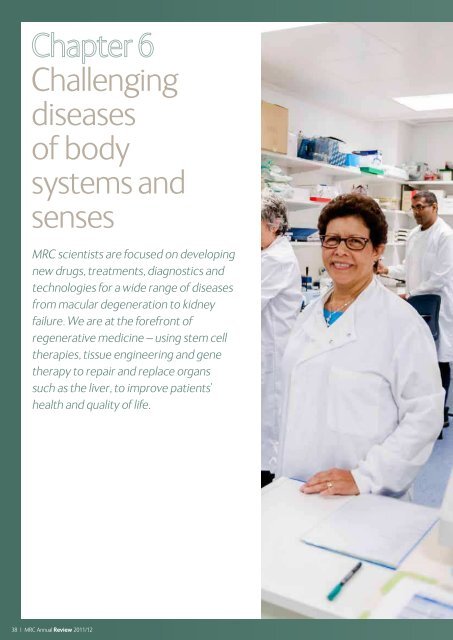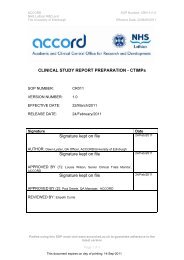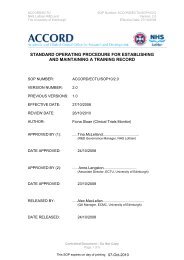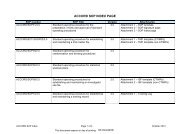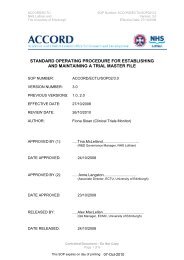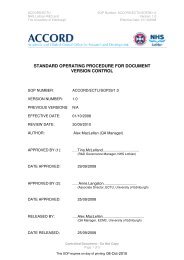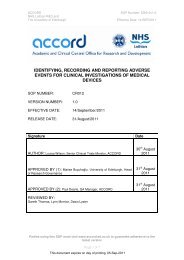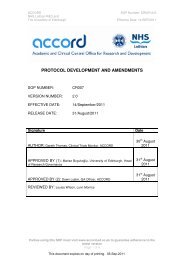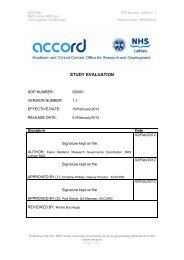Advancing medicine, changing lives - Medical Research Council
Advancing medicine, changing lives - Medical Research Council
Advancing medicine, changing lives - Medical Research Council
Create successful ePaper yourself
Turn your PDF publications into a flip-book with our unique Google optimized e-Paper software.
PROFILE: Professor Astrid Limb, Institute of Ophthalmology, London<br />
Challenging<br />
diseases<br />
of body<br />
systems and<br />
senses<br />
MRC scientists are focused on developing<br />
new drugs, treatments, diagnostics and<br />
technologies for a wide range of diseases<br />
from macular degeneration to kidney<br />
failure. We are at the forefront of<br />
regenerative <strong>medicine</strong> – using stem cell<br />
therapies, tissue engineering and gene<br />
therapy to repair and replace organs<br />
such as the liver, to improve patients’<br />
health and quality of life.<br />
Professor Astrid Limb partly owes her choice of research<br />
to a mistake made by a lab technician in 2002. At the time,<br />
Astrid’s lab was growing cultures of nerve cells from eyes<br />
and brains. But some of the cell culture flasks were mislabelled<br />
by the technician and a flask of nerve cells taken<br />
from the eye was grown under the wrong conditions.<br />
“When we came to study the cells later, we found that<br />
there was one cell line that seemed to be immortal,”<br />
explains Astrid. “Then the technician went on holiday and<br />
left behind cultures of human eye cells. We discovered that<br />
a similar population of human cells, grown under the same<br />
conditions, were also becoming immortal.”<br />
Astrid noticed that, under certain growth conditions, these<br />
cells acquired features of different nerve cells in the retina.<br />
She’d made a striking discovery: that there was a population<br />
of stem cells in the adult human eye which was able to<br />
generate many different types of nerve cell.<br />
Fast forward 10 years and stem cell research is a burgeoning<br />
field. Today Astrid leads research at the Institute of<br />
Ophthalmology in London which focuses on using the adult<br />
retinal stem cells she discovered, known as Müller glial stem<br />
cells, to regenerate the retina in vision disorders such<br />
as glaucoma.<br />
Glaucoma is a leading cause of irreversible blindness, with<br />
70 million sufferers worldwide. It occurs when a build up<br />
of pressure in the eye leads to the death of retinal ganglion<br />
cells (RGCs), which form the fibres of the optic nerve, and<br />
which transmit visual information from eye to brain. The<br />
condition can be treated in the early stages, but if diagnosis<br />
comes too late or if treatment doesn’t work, damage to the<br />
eye cannot be reversed.<br />
“Once people with glaucoma go blind there is no cure. So<br />
our hope is that we might be able to replace some of the<br />
nerve cells in the eye using stem cells,” Astrid says.<br />
In 2012, with funding from the MRC, Astrid’s group<br />
reported they’d successfully used Müller glial stem cells to<br />
repair nerve cells damaged in glaucoma, partially restoring<br />
vision in rats which had previously been blind.<br />
They used chemicals to induce Müller glial stem cells to<br />
grow into precursors of RGCs, before transplanting them<br />
onto the retinas of rats which had damage to their own<br />
RGCs. After four weeks, the injected cells appeared to have<br />
formed new connections (synapses) with existing nerve<br />
cells and the rats had significantly improved retinal<br />
function when their vision was tested under very low<br />
light conditions.<br />
This technique might lead to a new way of slowing or even<br />
reversing the deterioration of sight in glaucoma and other<br />
degenerative vision conditions if it can be applied in people.<br />
But human eyes are different to rats’ eyes because they<br />
have proportionately smaller lenses and also more liquid<br />
inside the eyeball, known as vitreous humour. If stem cells<br />
were to be injected into the vitreous humour in humans<br />
they would disperse and fail to attach to the retina.<br />
So the research team has recently begun seeding the stem<br />
cells onto a thin membrane of protein. They then surgically<br />
remove the vitreous humour from the eye and place the<br />
membrane on the retina to allow the cells to migrate to<br />
where they are needed.<br />
“The surgery we’re doing in animals is actually very similar to<br />
a routine operation in humans for retinal detachment, and<br />
we have a consultant ophthalmic surgeon from Moorfields<br />
Eye Hospital and an MRC clinician scientist who are helping<br />
us with this work,” explains Astrid.<br />
Having identified the cells, how to differentiate them, and<br />
proved that they are safe to use, Astrid is hopeful that the<br />
first clinical trials to use this technique might only be five<br />
years away. Long term though, she thinks that a different<br />
approach will be needed to restore sight permanently.<br />
“Because Muller glial stem cells are already present in<br />
the eye, I envisage that we might ultimately be able to<br />
encourage them to differentiate in the eye using drugs,”<br />
explains Astrid.<br />
Astrid’s career ambition is to establish a stem cell therapy<br />
for glaucoma and to help a blind person to see again, and at<br />
the current rate of progress she is nearly there. She regularly<br />
speaks to glaucoma patients and says they are a source of<br />
inspiration and motivation.<br />
“It’s a very debilitating condition, and it’s particularly<br />
upsetting to see children losing their sight from an early<br />
age and the effect that has upon them and their parents.<br />
And for adults, who have lived a normal life to suddenly lose<br />
their sight and not being able to cross the road alone or go<br />
shopping – it’s the end of their normal daily <strong>lives</strong>.<br />
“So if, by the end of my career I could establish a stem cell<br />
therapy for glaucoma and see just one person who has<br />
lost their sight to have their vision restored, that would be a<br />
dream – and then I can happily retire!”<br />
38 | MRC Annual Review 2011/12 MRC Annual Review 2011/12 | 39


